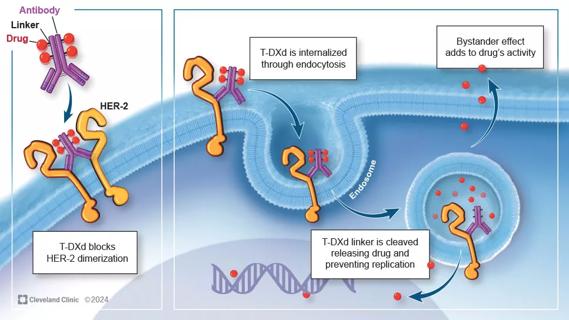Fine-tuning anti-androgen therapy shows promising results

Advertisement
Cleveland Clinic is a non-profit academic medical center. Advertising on our site helps support our mission. We do not endorse non-Cleveland Clinic products or services. Policy
Armed with new insights into how metastatic prostate tumors gain resistance to the next-generation androgen inhibitor abiraterone, Cleveland Clinic oncologist Nima Sharifi, MD, has discovered a way to make the drug’s activity more durable and potent.
Pairing abiraterone (abi) with the enzyme inhibitor dutasteride modifies abi’s metabolic conversion, blocking production of a tumor-promoting metabolite while aiding accumulation of another metabolite with strong anti-tumor effects, Dr. Sharifi and colleagues report in Nature. The study builds on his extensive previous research into prostate oncogenesis.
“These findings hold enormous potential for changing the way abiraterone is prescribed to patients,” says Dr. Sharifi who holds the Kendrick Family Endowed Chair for Prostate Cancer Research and is the study’s senior author. “While more work is needed to determine the ultimate clinical effect of biochemically altering abiraterone metabolism in this way, our team has identified a promising new combination therapy that stands to improve the care of men with metastatic castration-resistant prostate cancer.”
Prostate cancer is the second most commonly diagnosed cancer and the second leading cause of cancer deaths in American men. Most of the projected 26,120 U.S. prostate cancer deaths in 2016 will be due to metastatic castration-resistant disease.
Dr. Sharifi has spent years investigating androgen metabolism and the development and mechanisms of metastatic castration-resistant prostate cancer (mCRPC). Advanced prostate cancer initially regresses following gonadal testosterone deprivation therapy (either medical or surgical castration) but eventually recurs. This happens in large part because tumors acquire the ability to synthesize their own supply of testosterone and/or 5α-dihydrotestosterone (DHT) from nongonadal sources, particularly adrenal precursors, promoting signaling by the androgen receptor and enabling tumor progression and metastasis.
Advertisement
In a landmark 2013 study published in Cell, Dr. Sharifi identified the first example of a gene mutation present in human mCRPC tumors that increases the conversion of precursor steroids to DHT, permitting tumors to resume growth in the absence of gonadal testosterone.
Abi, approved by the Food and Drug Administration in 2011 and administered orally as abi acetate, blocks tumoral androgen synthesis by inhibiting the essential catalytic enzyme cytochrome P45017A1 (CYP17A1), thereby prolonging mCRPC patients’ survival. Ultimately, however, disease progression recommences and patients succumb.
In a 2015 Nature study exploring abi metabolism in prostate cancer patients, Dr. Sharifi and colleagues determined that abi is converted by the enzyme 3β-hydroxysteroid dehydrogenase (3 βHSD) to the more active Δ4-abiraterone (D4A). D4A, the researchers found, has more potent antitumor activity than its parent drug, blocking multiple steroidogenic enzymes and antagonizing the androgen receptor.
The latest Nature study by Dr. Sharifi’s group, published May 25, 2016, delves deeper into abi metabolism, showing that D4A is converted into at least six downstream metabolites (three by 5α-reductase and three by 5β-reductase) in prostate cancer cells, mice and human CRPC patients.
One of those metabolites, 3-keto-5α-abiraterone (5α-abi), is present at higher concentrations than its precursor, D4A, in prostate cancer patients who take abi acetate, and is an androgen receptor agonist that promotes tumor progression. The researchers found that treating CRPC xenograft-bearing mice with 5α-abi significantly shortened their progression-free survival (p < 0.01). Prostate cancer cells treated with abi developed the ability to enhance the breakdown of tumor-inhibiting D4A to tumor-promoting 5α-abi by upregulating the endogenous conversion enzyme steroid-5α-reductase (SRD5A).
Advertisement
In essence, Dr. Sharifi discovered that advanced prostate tumors co-opt abi metabolism to increase androgen synthesis while also accelerating elimination of the antitumor metabolite D4A.
Could the researchers improve abi’s efficacy by altering its metabolism to promote accumulation of “good” D4A and block its reduction to “bad” 5α-abi?
Dutasteride is a drug that inhibits SRD5A, the D4A-reducing enzyme. In a phase II clinical trial, Dr. Sharifi and colleagues tested the effect of adding dutasteride to the abi acetate treatment regimen in men with mCRPC.
Analysis of blood samples from 16 patients showed an 89 percent decrease in mean concentration of 5α-abi after addition of dutasteride, and a near-doubling in mean serum concentration of D4A. Dutasteride did not affect the amount of the three 5β-reduced abi metabolites, suggesting that it biochemically targets 5α abi metabolism with remarkable specificity.
Fine-tuning abi metabolism in this way should intensify the drug’s therapeutic benefit in mCRPC patients, though confirmatory randomized trials are needed. Manipulating the metabolic process to inhibit 5β-reductase might further elevate D4A and abi concentrations, producing additional therapeutic gains. Together, these findings shed light on a completely unanticipated aspect of abiraterone therapy and possible new directions for improving outcomes for patients with prostate cancer.
Advertisement
Advertisement

First-of-its-kind research investigates the viability of standard screening to reduce the burden of late-stage cancer diagnoses

Global R&D efforts expanding first-line and relapse therapy options for patients

Study demonstrates ability to reduce patients’ reliance on phlebotomies to stabilize hematocrit levels

A case study on the value of access to novel therapies through clinical trials

Findings highlight an association between obesity and an increased incidence of moderate-severe disease

Cleveland Clinic Cancer Institute takes multi-faceted approach to increasing clinical trial access 23456

Key learnings from DESTINY trials

Overall survival in patients treated since 2008 is nearly 20% higher than in earlier patients